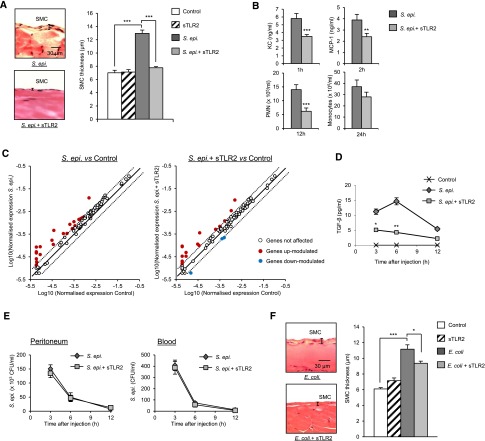Figure 8.
sTLR2 inhibits infection–induced peritoneal fibrosis development in vivo. C57BL/6J mice (n=5 per group) were inoculated intraperitoneally (A, C, and F) four times at weekly intervals or (B, D, and E) once with (A–E) live S. epidermidis (5×108 CFU per mouse) or (F) heat–killed E. coli (5×107 CFU per mouse) in the presence or absence of sTLR2 (250 ng per mouse). In A and F, 4 weeks after the last injection (day 49), histologic analysis of the peritoneal membrane was conducted as described in Figure 3. Representative fields (×40 magnification) are shown; bar plots show the mean (±SEM) of the submesothelial compact zone (SMC) thickness for each group. In B, D, and E, the animals were euthanized at the indicated time points after the injection, and peritoneal lavages and blood were obtained. Cytokine levels were determined by ELISA, PMN, and monocyte numbers by flow cytometry using anti-Ly6G– and anti-7/4–specific mAbs and bacterial titers by overnight culture on microbiologic agar plate. In C, scatterplots show the effect of sTLR2 on the S. epidermidis–induced modulation of fibrosis-related genes as assessed by quantitative RT-PCR on RNA extracted from peritoneal membranes 1 week after the fourth injection (day 28). S. epidermidis and sTLR2 versus S. epidermidis alone. *P<0.05; **P<0.01; ***P<0.01.

